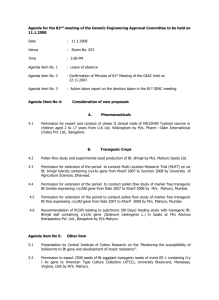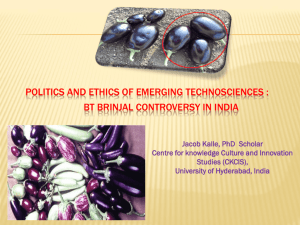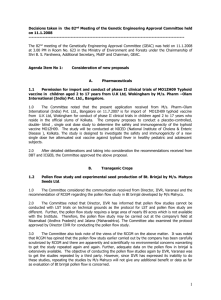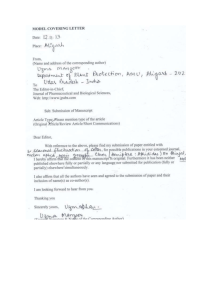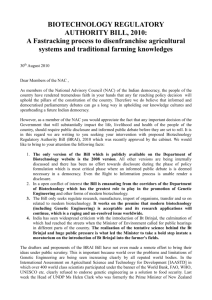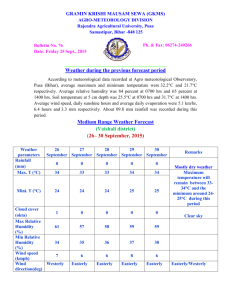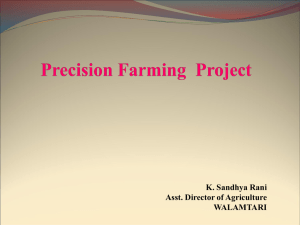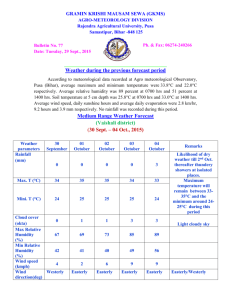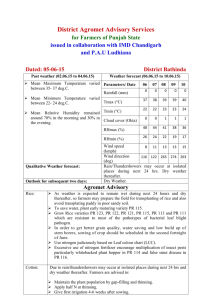seralini-background - India Environment Portal
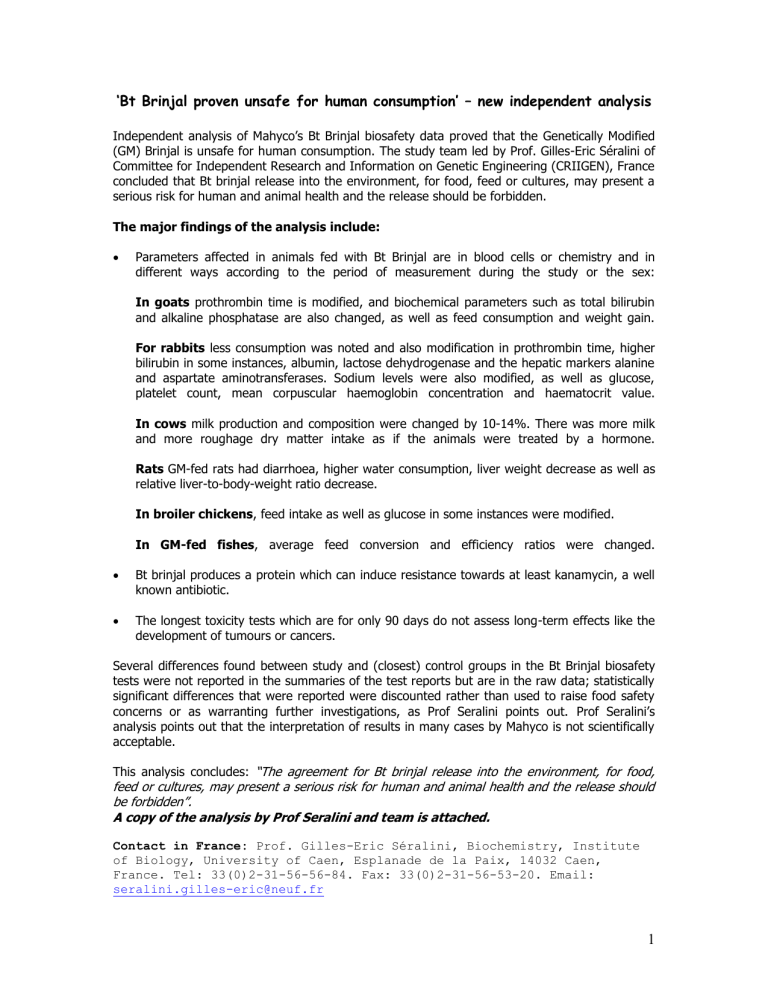
‘Bt Brinjal proven unsafe for human consumption’ – new independent analysis
Independent analysis of Mahyco’s Bt Brinjal biosafety data proved that the Genetically Modified
(GM) Brinjal is unsafe for human consumption. The study team led by Prof. Gilles-Eric Séralini of
Committee for Independent Research and Information on Genetic Engineering (CRIIGEN), France concluded that Bt brinjal release into the environment, for food, feed or cultures, may present a serious risk for human and animal health and the release should be forbidden.
The major findings of the analysis include:
Parameters affected in animals fed with Bt Brinjal are in blood cells or chemistry and in different ways according to the period of measurement during the study or the sex:
In goats prothrombin time is modified, and biochemical parameters such as total bilirubin and alkaline phosphatase are also changed, as well as feed consumption and weight gain.
For rabbits less consumption was noted and also modification in prothrombin time, higher bilirubin in some instances, albumin, lactose dehydrogenase and the hepatic markers alanine and aspartate aminotransferases. Sodium levels were also modified, as well as glucose, platelet count, mean corpuscular haemoglobin concentration and haematocrit value.
In cows milk production and composition were changed by 10-14%. There was more milk and more roughage dry matter intake as if the animals were treated by a hormone.
Rats GM-fed rats had diarrhoea, higher water consumption, liver weight decrease as well as relative liver-to-body-weight ratio decrease.
In broiler chickens, feed intake as well as glucose in some instances were modified.
In GM-fed fishes, average feed conversion and efficiency ratios were changed.
Bt brinjal produces a protein which can induce resistance towards at least kanamycin, a well known antibiotic.
The longest toxicity tests which are for only 90 days do not assess long-term effects like the development of tumours or cancers.
Several differences found between study and (closest) control groups in the Bt Brinjal biosafety tests were not reported in the summaries of the test reports but are in the raw data; statistically significant differences that were reported were discounted rather than used to raise food safety concerns or as warranting further investigations, as Prof Seralini points out. Prof Seralini’s analysis points out that the interpretation of results in many cases by Mahyco is not scientifically acceptable.
This analysis concludes:
“The agreement for Bt brinjal release into the environment, for food, feed or cultures, may present a serious risk for human and animal health and the release should be forbidden”.
A copy of the analysis by Prof Seralini and team is attached.
Contact in France: Prof. Gilles-Eric Séralini, Biochemistry, Institute of Biology, University of Caen, Esplanade de la Paix, 14032 Caen,
France. Tel: 33(0)2-31-56-56-84. Fax: 33(0)2-31-56-53-20. Email: seralini.gilles-eric@neuf.fr
1
Background
Brinjal is believed to have primarily originated in the Indian sub-continent, states Mahyco
(Monsanto’s Indian partner) in its dossiers on Bt Brinjal. Nowhere else in the world has a crop been allowed to be genetically modified in its centre of origin and diversity.
M/s Mahyco has been allowed to develop Bt Brinjal in India on claims of pest tolerance to a set of pests and of reduced chemical pesticide usage in brinjal cultivation.
The company has been allowed to do open air field trials from 2004 onwards even though biosafety has not been proven till date. In the process of field trials, Mahyco has also been documented with serious violations of biosafety norms under EPA.
In 2007, despite massive public resistance, an expert committee set up by the Genetic
Engineering Approval Committee (GEAC) recommended that Bt Brinjal be allowed for large scale field trials. The inexorable movement of Bt Brinjal towards commercial cultivation has been unstoppable despite several serious concerns and fundamental issues going unaddressed so far.
For instance, both in terms of academic literature and field level practice, it has been proven time and again that pest management in Brinjal is quite possible, affordable and profitable for farmers through non-chemical and non-GM means and through ecological practices. Despite the fact that
Dr Pushpa Bhargava, a Supreme Court appointee into the GEAC, recommending that GMOs should be considered only if no other options exist, Bt Brinjal is being projected as a need for the farmers of the country disregarding other safer options.
For assessing the implications of Bt Brinjal, the regulators had asked the crop developer to undertake some testing and to produce data – these tests are not long term, comprehensive in their assessment nor are they independent. Decision-making has been happening only on the basis of company-produced data when it obviously has a vested interest in the matter.
As part of the regulatory processes, Mahyco was asked to perform some toxicity and allergenicity tests for biosafety assessment on the health front (in addition to some tests for environmental biosafety and for assessing the impact of the Bt Brinjal on the target insects). The biosafety data from these tests was made public by the Genetic Engineering Approval Committee (GEAC) in
August 2008 after a protracted struggle under Right to Information by Greenpeace and in a
Supreme Court Public Interest Litigation by petitioners Aruna Rodrigues and others.
The fight for this data has been a typical case of public safety vs. commercial interest. It all started in February 2006 when Greenpeace approached the Department of Biotechnology (DBT) demanding the biosafety data generated and submitted to DBT by Mahyco under the RTI Act
2005. But DBT took a pro-Mahyco stand and endorsed their claim that the company’s commercial interests will be harmed if it is made public. However in April 2007, the Central Information
Commission (CIC) brushed aside this argument saying that the public’s right to know what is in their food is more important than the commercial interest of a private company. In a frantic effort to stop the information from being made public Mahyco approached the New Delhi High
Court. In December 2007, Mahyco obtained a stay order over the disclosure of data on grounds of the company could suffer commercial losses if the confidential data is disclosed to public. The case is still in the high court, while in August 2008 GEAC published the data in their official website.
There is no indication of any concerned Ministry taking up independent research or independent analysis with their own set of experts with regard to Bt Brinjal. Prof Seralini and his team analysed this data as the first ever independent analysis and show that Bt Brinjal is unsafe.
2
Glossary
Prothrombin time – how long it takes for (the liquid portion or plasma of) blood to clot and is connected with the liver.
Bilirubin – a pigment and breakdown product of hemoglobin, found in the bile and is connected with the liver.
Alkaline phosphatase – an enzyme produced mostly in the liver and also bone, intestines, kidneys etc.
Lactose dehydrogenase – an enzyme present in many organs; abundant in red blood cells.
Albumin – a protein vital for health
Haemotocrit value – is the red blood cell percentage or corpuscular volume in relation to total volume of blood (used as an indicator of anaemia etc.)
3
The following table presents a picture of the various (Food safety assessment) tests performed as part of regulatory requirements, Mahyco’s results and interpretations and Prof Seralini’s analysis.
Test Mahyco’s conclusion Prof Seralini’s analysis (For how many days and) by who?
Compositional analysis
Alkaloid content
Mahyco’s lab No appreciable differences
Indian
Institute of
Chemical
Technology between Bt Brinjal (three entries) and non-Bt Brinjal
(three) groups in the chemical constituents of moisture, proteins, oil, ash, carbohydrates, calories for fruit tissue and nitrogen, ash and crude fiber contents in leaf, stem and root tissues
No significant difference between Bt Brinjal and non-Bt
Brinjal fruit
Not clear if controls have been insecticide-treated in cultivation – this can change results
Bt Brinjal contains on an average,
15% less Kcal than control
Bt fruit powder and roots contain less solamargine; solasonine is more elevated in Bt fruits and roots than in non Bt.
Data do not allow to calculate the statistical significance of these differences (up to 237% for instance)
Sub-chronic feeding study in goats
Advinus
Therapeutics
Pvt Ltd.
90 days
Physical & ophthalmic examination did not reveal any abnormality; no clinical signs or pre-terminal deaths; no statistically significant differences in body weights and net body weight gains;
No statistically significant differences in feed consumption;
No statistically significant differences in haemotological parameters that could be considered of any physiological significance;
No significant differences in the clinical chemistry parameters that could be considered to be of physiological significance;
No treatment related gross pathological findings
The prothrombin time as well as total bilirubin was significantly higher in the GM-fed males at termination, and alkaline phosphatase was significantly lower.
Growth curve in Bt fed-males is below the others from Week 7. This group gained a lot less weight.
The feed consumption is lot less, even 25% less (week 5) only for this transgenic fed group. This is important although not clearly reported in the summary and obviously significant after curves observation. This appears to be a sex-dependent effect like for endocrine diseases.
Bt brinjal as an animal feed, or human food cannot be considered as safe with such results.
4
Test
Sub-chronic feeding study in rabbits
(For how many days and) by who?
Advinus
Therapeutics
Pvt Ltd.
90 days
Mahyco’s conclusion
No toxic or clinical signs observed;
No changes in body weight or cumulative weekly net body weight gains in any group;
No changes observed in feed intake;
No changes observed in haemotological parameters;
No changes observed in clinical chemistry parameters that could be considered to be of biological significance;
No treatment related gross pathological changes observed.
Prof Seralini’s analysis
There was a reduction of consumption at week 6 in the male
Bt group in comparison to non Bt;
The GM fed males consumed less in general, in the female group at week 11 (due to one animal, but the groups are too limited in numbers of animals unfortunately to calculate a real statistical significance) as if the
Bt brinjals were less palatable. The females consumed less Bt brinjal.
There was at interim blood sampling an increase in albumin and total bilirubin in GM fed males versus adequate controls, and of total bilirubin and lactose dehydrogenase in GM fed females; at terminal blood sampling again a significant increase of total bilirubin in males and females GM fed, increases in hepatic markers alanine and aspartate aminotransferases and sodium levels in GM fed males, a decrease of glucose levels in GM fed females.
The platelet count was significantly reduced during the experiment as well as mean corpuscular haemoglobin concentration in the blood of Bt fed males in comparison to their controls, an increase in haematocrit value; prothrombin time was increased in females.
The Bt brinjal cannot be considered as safe in these conditions, by contrast to what is claimed by the Company. If these results are examined in parallel to the significant differences in the parameters for goats, the side effects of Bt brinjal are very worrying and need further scientific investigations.
5
Test
Feeding study in (lactating, crossbred) cows
(For how many days and) by who?
42 days
Sub-chronic oral toxicity study in
(Sprague
Dawley) Rats
Intox Pvt
Ltd;
90 days
Mahyco’s conclusion
No significant difference in milk yield, 4% FCM yield, fat yield and SNF yield;
Values for total solids, protein, fat, lactose, ash, solids-not-fat content did not differ significantly between the groups;
No significant difference in body weight gain;
Bt protein not detected in blood or milk of cows.
No remarkable and treatment related incidence of clinical abnormalities;
Body weight gains of Bt Brinjal treated group comparable with non-transgenic Brinjal group;
Average values of daily food and water consumption comparable;
Values of haemoglobin, packed cell volume, total and differential WBC counts, total
RBC count, RBC indices, platelet count, ESR, prothrombin time, clotting time comparable;
Clinical chemistry comparable;
Absolute and relative weights of liver, kidneys, adrenals, testes/ovaries, spleen and brain comparable;
Prof Seralini’s analysis
Cows eating GM brinjal produced significantly (14.3%) more milk, almost as if they were treated by a light hormone, in 42 days only. The ash content of the milk varied significantly for transgenic brinjalfed cows between the second and fourth week, by the end of the experiment they had significantly more roughage dry matter intake
(10.5%).
It cannot be concluded from this experiment that there are no metabolic changes after Bt brinjal consumption in lactating cows and thus this feed cannot be considered as safe.
This was badly designed, from a scientific point of view, increasing control animals by 2 in regard to treated rats. This was unexplained.
Circling disorder and diarrhea were noticed only in the Bt brinjal group, males and females.
Moreover liver weight as well as relative liver to body weight ratio decreased in the dose range study in females, by 13% apparently significantly. For the rats fed Bt brinjal water consumption was 8-
21% more than the non Bt brinjal group for some periods. The significance of this claimed to be null. However, all the scientific committees consulted agree with companies that statistical significant differences have been reported during 90 day studies between control and treated rats with different GMOs on numerous parameters, including blood composition and detoxification organs such as kidneys.
Bt brinjal cannot be considered safe for rats considering these results.
6
Test
Feeding study in broiler chickens
(For how many days and) by who?
Central
Avian
Research
Institute;
42 days
Feeding studies on common carps
Central
Institute of
Fisheries
Education
45 days
Mahyco’s conclusion
Body weight gain, feed intake and feed conversion ratio did not suffer due to dietary treatments;
Different blood biochemical constituents such as different cholestorals, hemoglobin, protein and uric acid as well as heterophyl-lymphocytes ratio did not suffer statistically due to dietary treatments.
No statistically significant differences in survival of common carps;
Average weight gain, growth increment, aggregate length & weight increment, final weight gain, specific growth rate, feed conversion ratio, feed efficiency ratio and protein efficiency ratio were statistically similar across treatments;
Prof Seralini’s analysis
40 unsexed chickens received 5% Bt brinjal in their diet, 40 others, 10%, and 200 received different non GM diets. This was not a good design to detect any unintended GM effect in these conditions. In particular 10% is too low a percentage to clearly see unintended effects.
Moreover there is only one species of bird studied for a limited period of time.
The feed intake for GM-fed broilers
(10% Bt-brinjal) was 10% lower than in the corresponding control
(10% non Bt brinjal in the diet) at different weeks (21-35 days of age) and then higher, the implication of this is a differential metabolism between both groups but the experimental report did not calculate the statistical significance of this difference. The blood glucose was also significantly different in the Bt group.
The authors of the experiment write that there is no significant difference due to Bt brinjal consumption by chickens, but these differences lead instead to the conclusion that the Bt brinjal cannot be considered as safe according to this experiment.
There were numerous unnecessary non-transgenic control groups masking the significant effects between the two closest groups, Bt and non Bt. There were only 6 pools of 60 fishes (360) receiving Bt brinjal in the feed on a total of 24 pools, i.e. 1440 fishes, instead of having two main groups. This disproportion can mask a lot of significant effects if only a small group is compared with all the others.
7
Primary skin irritation tests on (New
Zealand white) rabbits
Intox Pvt
Ltd;
Patches on dorsal skin for 4 hours and observation upto 72 hours
No significant difference in histo-pathological alterations in gill, liver, intestine & kidney tissues
No erythema or edema observed after patch removal.
Irritancy index was 0.0
Average feed conversion and efficiency ratios were significantly higher in the Bt group versus closest control, at 45% brinjal in the diet.
No safety can be concluded.
Three rabbits only were treated with Bt brinjal on a total of 12; this is not serious at all.
8
